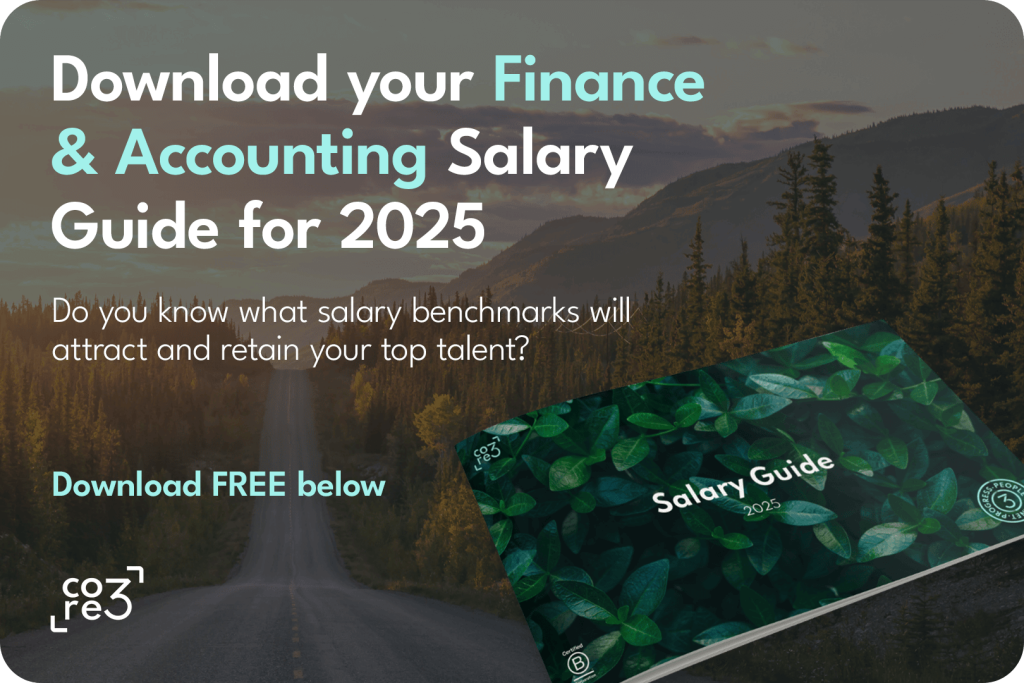Back in June, Chancellor Rachel Reeve delivered her first multi-year spending review speech. There were big increases in investment spending for health defence, energy, transport and business. Skills and education? Not so much.
But beyond the political soundbites, what does this actually mean for employers, jobseekers, and finance professionals trying to plan workforce strategy?
We sat down with Neil Carberry, CEO of the REC (Recruitment & Employment Confederation), to talk practically about the current state of the UK labour market and what the review means for business leaders.
The Market’s Not Broken. But It’s Not Moving Fast Either.
The UK labour market isn’t broken. Employment is holding up, unemployment remains low, and the overall stock of people in work is strong. But beneath that stability, the flow has been pretty slow, which in simple terms means people aren’t moving.
The number of people switching roles, moving sectors or entering new parts of the workforce has been sluggish for almost three years. When flow slows, so does innovation, career progression and internal movement across the economy.
So what’s driving the slowdown? Neil points to three key dynamics:
1, Post-pandemic Job Security Psychology
In 2020, hiring froze almost overnight. Then 2021 and 2022 exploded with recruitment demand. But since early 2023, the market has hit what Neil calls “treacle.” People are still wary. The trauma of the pandemic didn’t just disrupt work, it fundamentally changed the way people think about risk and stability.
2, Hybrid Working Has Made Change Harder
“If I’m in a business now where I get two days at home and it works for me, that becomes part of my decision-making,” Neil explained. Candidates are cautious about giving up flexibility. They’re weighing cultural fit, work-life balance, and predictability more heavily than ever. Moving roles now isn’t just a new job, it’s a change in lifestyle.
3, Embedded Expectations in Permanent Roles
There’s a growing mismatch between what companies expect and what candidates are willing to compromise on. The pre-pandemic 9-to-5 office routine has gone. Today, flexibility is baked into people’s conditions. That means there’s much more to starting a new job. It’s not just about pay or title, it’s about what life looks like in the role.
All of this slows labour market fluidity. And when you combine that with wider economic caution, it creates a market that looks healthy on paper, but feels sluggish in practice.
Neil commented, “We expected a pick-up by spring this year, but it hasn’t materialised yet. Some of it is economic headwinds. But a lot of it is structural. People are thinking twice, and employers are navigating that too.”
Employers Believe in Themselves but Don’t Trust the Economy
One of Neil’s key observations, based on REC’s jobs outlook data, suggests that businesses feel solid. They believe in their business models, believe in their teams, have adapted post-Covid and are clearer than ever on what makes them resilient.
But when it comes to the wider economic picture, it’s a different story. The market’s hesitancy isn’t coming from a lack of ambition. It’s coming from noise, risk and uncertainty. Here’s what’s holding decision-makers back:
1. National Insurance and Tax Anxiety
Neil highlighted the NI increase as the first major pause button for employers this year. But it’s not the only one. Now there’s growing concern about where the next tax rises will come from, especially after recent welfare reforms. Employers are already anticipating an autumn budget that could hit them again.
2. Uncertainty Around Interest Rates and Global Economics
Interest rates are still up in the air. Borrowing costs remain volatile. And internationally, things aren’t exactly stable either. Neil called out potential Trump-era tariffs and trade wars as a wildcard already on leaders’ radars, long before an election has even happened.
This macro-level unpredictability makes long-term hiring commitments feel risky. So employers press pause because they’re wary of what might hit the balance sheet next.
3. Risk is Back on the Table
Neil also pointed out a mindset shift. From 2007 to 2022, business leaders operated in an unusually low-risk climate. Money was cheap. Interest rate were low. Wages were stable. Growth came without much friction. But now, input costs are higher. Pay inflation is real. Hiring decisions carry more weight.
“We’re not in a low-risk world anymore,” Neil said. “We’re back to a pre-2008 dynamic where you actually have to weigh up the risk with the reward.”
Some employers are adjusting to that reality faster than others. Until this outdated risk profile catches up, hesitancy will hang around.
The Spending Review Isn’t Moving the Needle
Neil didn’t sugarcoat it. “In the private sector, [the Spending Review will have] next to zero impact.”
Most of the firepower in the review was aimed at the public sector, and even then, not evenly. Yes, the NHS secured a meaningful uplift. Defence spending got a long-term boost. But beyond that; funding for local government, education, social care and skills development remains tight.
For public sector employers, this creates more pressure than opportunity. Tight budgets and rising expectations mean workforce planning will need to be sharper, more creative and more resilient.
For the private sector, Neil was clear: this review doesn’t shift the dial. If you were holding back on hiring in Q2, nothing in this review gives you a reason to unfreeze.
The Skills Investment Void
One of the most telling omissions in the review was around skills and education. There’s no serious commitment to long-term talent development or any hint of a framework to tackle the UK’s ageing workforce.
Neil said this is a bit of a red flag for employers.
“It’s very noticeable that there wasn’t a lot of money for skills or education. So if you’re a CFO thinking about succession, transformation or tech fluency, it’s going to fall on you to build the capability.”
If entry roles are being stripped out by automation and there’s no investment in training new talent, how do you grow your next generation of leaders?
Where the Hiring Opportunities Are Taking Shape
Despite the cautious tone of the market, some sectors are quietly heating up (and largely reflect the government’s investment).
- Green energy and clean tech including nuclear, carbon capture and insulation
- Infrastructure and construction especially in the North and Midlands
- Defence and advanced manufacturing with long-term capital committed
- Professional services and consulting which includes finance, accountancy, and recruitment itself
If you’re a CFO or finance leader, you need to pay close attention to the sectors adjacent to yours. Look at clients, partners, and competitors because they may start hiring quickly and at scale. If you’re not watching the ripple effects, you could get caught on the back foot.
“The industrial strategy is doing a lot of the heavy lifting. If you’re in or near one of those eight priority sectors, expect more wind at your back.”
However, this isn’t across the board. AI and automation are already reducing hiring in areas like entry-level admin, retail and warehousing and front-line education and public service roles.
These changes reflect a shift in how work is structured. That means leaders need to be more strategic about where they invest in people and where they redesign roles completely.
So at the moment, there’s no hiring boom. But there are signals. And smart businesses are tracking them early.
What Employers Should Do Now
“The best candidates aren’t waiting. If you want to hire well, move before the crowd does.”
In other words, if you’re waiting for perfect clarity, you’re already behind according to Neil. The market hasn’t picked up pace yet, but when it does, the competition for high-quality talent will spike and hiring will get harder, not easier.
If your business is in a stable position, this is the time to act. Not react.
1. Hire Ahead of the Curve
The temptation is to wait until everything is right before opening roles. But the best people, whether they’re senior operators, future leaders or commercially-minded finance pros, are more available now than they will be in six months. Get in early and invest in capability while others are still hesitating.
2. Redesign, Don’t Refill
AI is shifting workflows. Hybrid is shaping culture. And cost pressures are forcing smarter, leaner operations. That means it’s no longer about replacing what you had. It’s about redesigning roles for where you’re going.
Neil says there’s a huge opportunity for you to rethink how your organisation works, call on different skills and reshape productivity. So perhaps its time to ask yourself:
-
- Are we clear on what our finance team will need to do, not just what it will look like?
- Which roles will be more advisory, analytical, or AI-augmented?
- Are we hiring for capability, or just familiarity?
3. Rebuild the Pathways
One of the bigger long-term risks is talent depth. If entry-level roles are being automated and early-career pathways are underfunded, how are you developing the next layer of leadership?
“If you’re removing junior roles, but not replacing that learning journey somewhere else, you’re going to hit a leadership wall in three to five years.”
Now is the time to think about apprenticeships, internal mobility and career progression as part of hiring strategy.
4. Balance Short-Term Caution with Long-Term Intent
Yes, there are still macro risks. But if your instinct is to wait for certainty, you may find yourself hiring in a crowded, expensive market that has fewer great candidates. But acting now will help you secure the best talent.
What Jobseekers Should Know
The headline for jobseekers is that there are jobs out there, but landing one is harder than it looks.
On the surface, the market appears active. Roles are being posted. Companies are still hiring. But under the hood, hiring cycles are slower, roles are being redefined and AI is handling the first round of filtering.
“It’s very easy to have a lot of information when looking for a job. But what matters is intelligence. A great candidate knows how to stand out, not just show up.”
So if you’re looking for finance roles right now, here’s how you can make an impression.
1. Make Human Connections
AI-generated applications might tick boxes. But they rarely spark conversation. The goal isn’t just to get through the algorithm, you need to reach a real person. Try sending a thoughtful message. Ask a smart question. This will show that you’ve done the work. In a sea of generic CVs and templated cover letters, the human touch cuts through.
2. Use the Side Doors
Full-time roles aren’t the only way in. Temp contracts, project work, statement-of-work gigs and industry thought-leadership events all offer exposure and add credibility. Neil called it “getting through the window, not the door.” It’s about being visible, useful and in the right rooms. That’s often what leads to real opportunities.
3. Focus Your Energy
Spraying out dozens of AI-polished applications won’t give you an edge. You should look at roles where you can add value and that align with your strengths. And be ready to explain why you’re a strong fit – not just what you’ve done.
Be Ready for the Turn
Yes, the market is muted. Confidence is still building. But momentum is coming. Hiring will pick up pace and demand will rise. And when it does, the businesses and individuals who’ve stayed focused, stayed visible and stayed intentional will be the ones out in front.
There’s no need for panic hiring or knee-jerk decisions. But if you’re a hiring manager, a team leader or a jobseeker figuring out your next move, now’s the time to get your house in order.
And if you’d like an outside perspective on your hiring strategy, your candidate pipeline or how to rethink your structure, we’re always here for a conversation.





